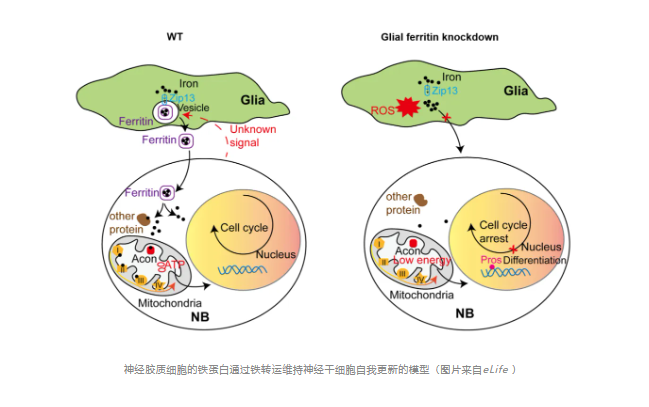14
2024
-
09
Wang Su's team at Southeast University found that microenvironmental glial cells regulate stem cell self-renewal and differentiation by delivering iron to neural stem cells through ferritin
Author:
When there is a lack of iron in the food, the brain development of the fruit fly is obviously defective and the volume becomes smaller. After further observation, iron deficiency will lead to a decrease in the number of neural stem cells, decreased proliferation. In addition, the team found that knocking down the ferritin-encoding gene that stores iron in glial cells can also lead to brain development defects, a decrease in the number of stem cells, and a significant decline in proliferation. Next to explore the mechanism, the authors found that ferritin in glial cells will be transported to stem cells, providing them with iron, so as to maintain the energy production of stem cells, so that they can carry out normal self-renewal and proliferation. Combined with the data of Shengxin, the NAD of stem cells after knocking down ferritin was further determined.+Defects in generation, energy generation, biosynthesis, etc. More importantly, energy production can be partially restored by overexpressing NADH dehydrogenase Ndi1 in stem cells, rescuing the stem cell loss phenotype. After a series of analysis, it was finally proved that the loss of stem cells caused by ferritin knockdown was caused by the lack of energy and the early differentiation of stem cells, rather than due to the origin defect or apoptosis.

LATEST NEWS
2024-09-16
Tsinghua University Xiao Bailong/Peking University Ouyang Kunfu Collaboration Reveals Key Phosphorylation Sites That Regulate Piezo1 Mechanical Sensitivity and Mechanotransduction Function in Vivo
Piezo1 is a mechanically activated cation channel that can convert mechanical forces into various physiological processes. Due to its large protein size of more than 2500 amino acids and complex 38 transmembrane helix topology, how Piezo1 is post-translationally modified to regulate its mechanotransduction function in vivo remains unexplored.
2024-09-18
Huazhong University of Science and Technology Wang Cong Yi/Sun Fei found in obese environment really pathogenic adipose tissue macrophage subsets
Adipose tissue macrophages (ATMs) play an important role in maintaining adipose tissue homeostasis and coordinating metabolic inflammation. Given the extensive functional heterogeneity and phenotypic plasticity of ATMs, there is a need to identify truly pathogenic subpopulations of ATMs in the context of obesity.
2024-09-14
Wang Su's team at Southeast University found that microenvironmental glial cells regulate stem cell self-renewal and differentiation by delivering iron to neural stem cells through ferritin
The study of neural stem cells is of great significance for the treatment of neural development and nervous system diseases. However, the regulation mechanism of neural stem cells has not been fully elucidated, especially the regulation of neural stem cells by microenvironment is relatively less known.
2024-09-14
Subversion of the past! Tsinghua University Dai Qionghai/Guo Zengcai/Wu Jiamin Cooperation Latest Cell
A comprehensive understanding of physiopathological processes requires non-invasive live three-dimensional (3D) imaging on different spatial and temporal scales. However, huge data throughput, optical non-uniformity, surface irregularities, and phototoxicity pose huge challenges, resulting in inevitable trade-offs between volume size, resolution, speed, sample health, and system complexity.
2024-09-11
The latest research by Guo Jianping/Cheng Chao/Bo Lang of Sun Yat-sen University confirms that palmitic acid can suppress virus infection by activating innate immunity!
Innate immunity is the primary defense against viral and microbial infections. The exact effect of cellular metabolites, particularly fatty acids, on antiviral innate immunity remains largely elusive.

